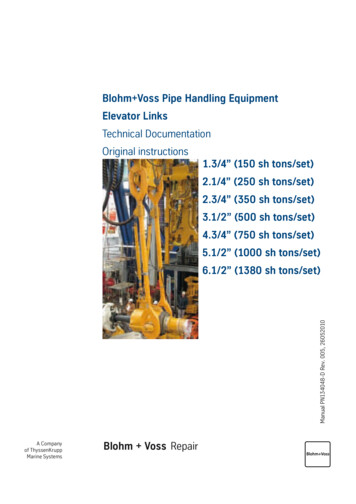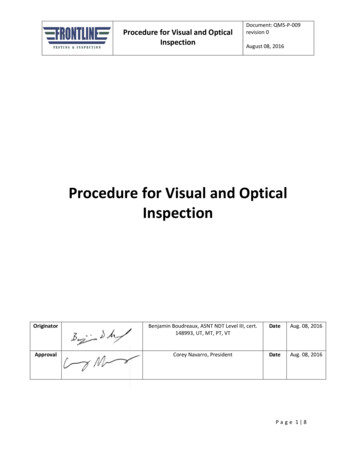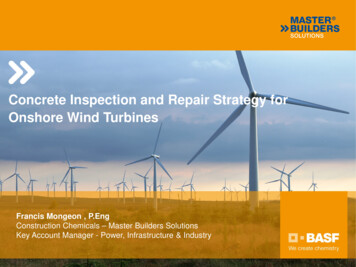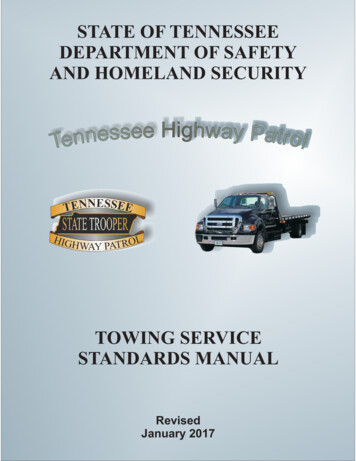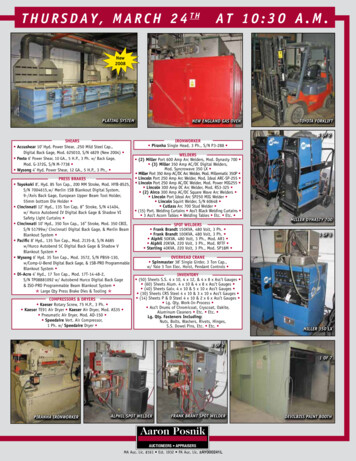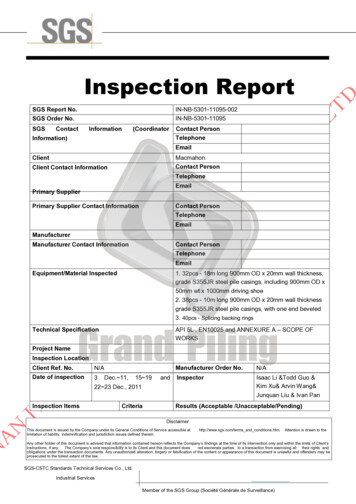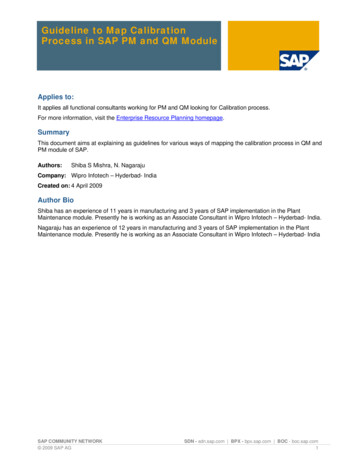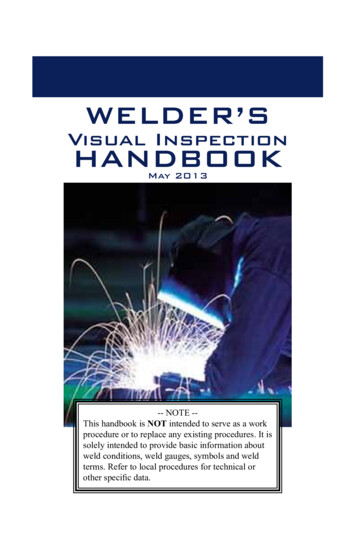
Transcription
WELDER’SVisual InspectionHANDBOOKMay 2013-- NOTE -This handbook is NOT intended to serve as a workprocedure or to replace any existing procedures. It issolely intended to provide basic information aboutweld conditions, weld gauges, symbols and weldterms. Refer to local procedures for technical orother specific data.
Click on any of the items under the Table of Contents to go to thatpage.Table of ContentsPageVisual Inspection Responsibilities and TechniqueiHow to Measure Fillet Weld Size1Cracks 2VT AttributesUnderfill4Burn Through 6Incomplete Fusion 8Roughness 10Overlap 12Undersized Fillet Weld14Incomplete Penetration 16Undercut 18Corner-Melt 20End-Melt 22Concave Fillet Weld24Convex Fillet Weld 26Arc Strikes 28Other Fabrication Scars 30Porosity 32Spatter34Slag 36Weld Reinforcement 38Melt Through40Offset42Oxidation44Crater Pit46Paint48Types of Weld Joints 50Parts of a Weld 53Structural Joint Numbering System54Standard Welding Symbol Layout60Standard Welding Symbols 61Using Finger Gauge 67Using Bridgecam Gauge 70Definitions73
Visual Inspection Responsibilities1.2.When – Final visual inspections must be performed:a)When the weld is complete, and in the final surface and heat treated conditionsb)Before other NDT (when required)c)Before being made inaccessible for inspectionWhere – the weld inspection zone:a)All work - Completed weld faces plus ½ inch onboth sides of weld shall be visually inspected forthe entire length of the weld.b)To gauge weld size:(1). Gauge where the weld size visually appears to be the smallest(2). If the weld length is five feet or less, gaugea minimum of once per weld(3). If the weld length is greater than five feet,gauge a minimum of once every five feetVisual Inspection Technique1.2.What – In order to perform final visual inspection youneed:a)Adequate lighting (use flashlight as needed)b)Weld gauges (bridge cam and finger gaugesrecommended)c)Prescription glasses (as required)How – Distance and angle:a)The inspector’s eyes should be within 24 inchesof the surface to be inspected andb)At an angle of at least 30 degrees to the surfacebeing inspected.iBack toTable of Contents
How to Measure FILLET WELD SIZELegSize(Correct Size)The leg lengths and throat of the largest triangle that canbe drawn within the fillet weld cross section.Throat*SizeLegLeg/SizeThroat*Leg/Size* See parts of a weld1Back toTable of Contents
CRACKS2Back toTable of Contents
CRACKSDefinitionA tear, fracture or fissure in the weld or base metalappearing as a broken, jagged or straight line.NOTE: Cracks are the most serious defect!Preventive Action1. Remove contaminants from the joint (rust,grease, moisture, etc.) prior to welding.2. Apply and maintain required preheat.3. Do not allow the base material to cool tooquickly.4. Maintain filler metal control requirements.5. Use correct filler metal type for the joint.6. Apply proper bead size and sequencing toeliminate excessive distortion and/or stress inthe base material.Corrective ActionRepair in accordance with local procedures.3Back toTable of Contents
UNDERFILL4Back toTable of Contents
UNDERFILLDefinitionThe amount of weld that is below a straight linedrawn from the edges of the joint preparation ofa groove weld, with the exception of allowableundercut.Preventive Action1. During welding of the reinforcement, gaugebead heights in any location that appears to belower than the rest of the bead.2. Adjust amps/volts.3. Slow travel speed to allow increased weldpuddle volume.4. Sequence weld passes so that the toes of thebeads sufficiently cover one another,minimizing valleys.Corrective ActionApply additional weld beads until the joint isadequatly filled. (flush or above)5Back toTable of Contents
BURN THROUGH6Back toTable of Contents
BURN THROUGHDefinitionExcessive heat and/or penetration that results in ahole completely through the backing ring or strip,fused root, or adjacent base material.Preventive Action1.2.3.4.Reduce amps/volts.Increase travel speed.Maintain appropriate arc length/wire stickout.Use ceramic tape or approved metal backingstrap on areas with root gap.Corrective Action1. Place ceramic tape or approved metal backingstrap on the bottom side of the hole.2. Weld repair the first side of the hole from theeasiest side to weld.3. Once sufficient weld metal has been depositedon the easiest top side, grind or carbon arc theother side of the hole to sound metal.4. Weld the other side of the hole to theappropriate size or height.7Back toTable of Contents
INCOMPLETE FUSION8Back toTable of Contents
INCOMPLETE FUSIONDefinitionA situation where the weld metal does not fuseor completely bond with the base metal or previously deposited weld metal.Preventive Action1.2.3.4.5.Increase amps/volts.Decrease travel speed.Maintain appropriate arc length/wire stickout.Adjust torch/rod angle.Ensure previous beads are free of overlap(bead roll-over) and slag prior to weldingadditional passes.Corrective Action1. Grind or carbon arc the weld to sound metal.2. Weld repair the affected area.9Back toTable of Contents
ROUGHNESS10Back toTable of Contents
ROUGHNESSDefinitionSharp ridges (irregularities) or deep valleys between weld beads. The angle formed between theadjacent beads of the weld must be 90 or greater.Preventive Action1. Adjust amps/volts.2. Maintain a consistent travel speed.3. Maintain appropriate arc length/wire stickout.4. Adjust torch/rod angle.5. Sequence weld passes so that the toes of thebeads sufficiently cover one another,minimizing valleys.6. Consult local Welding Engineering in caseswhere the base material is magnetized.Corrective Action1. Grind or carbon arc the weld to sound metal.2. Weld repair the affected area, if needed.11Back toTable of Contents
OVERLAP12Back toTable of Contents
OVERLAPDefinitionA condition where the weld metal rolls overforming an angle less than 90 . Sometimesreferred to as “weld bead rollover.”Preventive Action1.2.3.4.Adjust amps/volts.Increase travel speed.Maintain appropriate arc length/wire stickout.Adjust torch/rod angle.Corrective Action1. Grind or carbon arc the weld to sound metal.2. Weld repair the affected area, if needed.13Back toTable of Contents
Throat*UNDERSIZED FILLET WELD* See parts of a weld14Back toTable of Contents
UNDERSIZED FILLET WELDDefinitionAny fillet or fillet reinforced weld that does notmeet the minimum size requirements specifiedon applicable fabrication documents.Note: Skewed fillets are exceptionally prone tohaving undersized weld on sidesthat have greater than 90 joint fit-up.Preventive Action1. Apply weld layers until weld size is met on allsides of joint.2. Adjust amps/volts.3. Decrease travel speed.4. Maintain proper wire stickout.5. Adjust torch/rod angle.6. Avoid over grinding.7. Sequence weld passes so that the toes ofthe beads sufficiently overlap one another.Corrective ActionApply additional weld passes until the affectedareas are the proper size.15Back toTable of Contents
INCOMPLETE PENETRATIONPipe16Back toTable of Contents
INCOMPLETE PENETRATIONDefinitionA situation where the weld metal does notpenetrate as deeply as required.Preventive Action1. Increase the bevel angle and/or root openingof the fit-up. Do not exceed the requirementsof the joint design.2. Ensure bevel edges of both members arelined up properly.3. Increase amps/volts.4. Decrease travel speed.5. Maintain appropriate arc length/wire stickout.6. Adjust torch/rod angle.Corrective Action1. Grind or carbon arc the weld to sound metal.Note: Backgouge 2nd side to full penetration(remove fusion lines). Often, more thanone fusion line will be present during backgouging.2. Weld repair the affected area.17Back toTable of Contents
UNDERCUTBRIDGECAMUNDERCUT GAUGE18Back toTable of Contents
UNDERCUTDefinitionA groove melted into the base metal and leftunfilled by weld metal.Preventive Action1. Decrease amps/volts.2. Decrease travel speed.3. Maintain appropriate arc length/wire stickout.4. Adjust torch/rod angle.5. Feed more wire into the puddle when manual TIG welding.6. Increase stop time (dwell time) on weavedbeads.7. Use undercut gauge to verify acceptability.Corrective Action1. Grind the toe of the weld until the unacceptable undercut blends smoothly into the basematerial.2. Weld repair the affected area, if needed.19Back toTable of Contents
CORNER-MELT“as is”conditiongroundcondition20Back toTable of Contents
CORNER-MELTDefinitionA groove melted in a corner of a welded member that is left unfilled.Preventive Action1. Start welds at end of joint and work inward.2. Decrease amps/volts.3. Decrease travel speed.4. Maintain appropriate arc length/wire stickout.5. Adjust torch/rod angle.6. Feed more wire into the puddle when manual TIG welding.7. Increase stop time (dwell time) on weavedbeads.8. Use undercut or bridgecam gauge to verifyacceptability.Corrective Action1. Grind the toe of the weld until the unacceptable corner-melt blends smoothly into thebase material.2. Weld repair the affected area, if needed.21Back toTable of Contents
END-MELT“as is” conditionground conditionGauged1/4” or less22Back toTable of Contents
END-MELTDefinitionA groove melted into the end of a ¼ inch orless welded member that is left unfilled by weldmetal.Preventive Action1. Start the weld passes at the ends, wherepossible.2. Decrease amps/volts.3. Decrease travel speed.4. Maintain appropriate arc length/wire stickout.5. Adjust torch/rod angle.6. Feed more wire into the puddle when manual TIG welding.7. Increase stop time (dwell time) on weavedbeads.8. Use undercut or bridgecam gauge to verifyacceptability.Corrective Action1. Grind the toe of the weld until the unacceptable end-melt blends smoothly into the basematerial.2. Weld repair the affected area, if needed.23Back toTable of Contents
CONCAVE FILLET WELDgauged24Back toTable of Contents
CONCAVE FILLET WELDDefinitionA fillet weld that sinks in the center.Preventive Action1.2.3.4.5.Adjust amps/volts.Decrease travel speed.Maintain appropriate arc length/wire stickout.Adjust torch/rod angle.Feed more wire into the puddle when manual TIG welding.6. Increase stop time (dwell time) on weavedbeads.7. Sequence weld passes so that the toes ofthe beads sufficiently cover one another.Corrective ActionApply additional weld passes until the concavityrequirements have been met.25Back toTable of Contents
CONVEX FILLET WELDgaugedConvexityCheck Convexity usingthe Proper Size Wire26Back toTable of Contents
CONVEX FILLET WELDDefinitionA fillet weld that bulges out in the center.Preventive Action1.2.3.4.5.Adjust amps/volts.Increase travel speed.Maintain proper wire stickout.Adjust torch/rod angle.Feed less wire into the puddle when manualTIG welding.6. On multiple pass welds, avoid placing beadstoo close together.Corrective ActionGrind, carbon arc or weld the affected area untilthe convexity requirements have been met.27Back toTable of Contents
ARC STRIKES28Back toTable of Contents
ARC STRIKESDefinitionA discontinuity consisting of any localized remelted metal, heat effected metal, or change insurface profile of a finished weld or base material surface resulting from an electrical arc.Note: Arc strikes may develop stress risers,which could lead to cracking.Preventive Action1. Prior to energizing welding equipment, replace damaged welding lines and groundcables.2. Ensure grounds are properly installed.3. Hang lines on trees or J-hooks.4. Keep gas cups free of weld spatter on fluxcore processes.5. Do not allow sub-arc tips to contact the basematerial.6. Be careful when striking an arc.Corrective Action1. Grind the affected area until the unacceptable arc strike blends smoothly into the basematerial or weld face.2. Weld repair the affected area, if needed.29Back toTable of Contents
OTHER FABRICATION SCARS30Back toTable of Contents
OTHER FABRICATION SCARSDefinitionAny accidental groove or cut that penetratesthe surface of the metal. Sometimes callednicks, gouges or handling marks.Preventive Action1. Avoid dropping heavy or sharp objects onwelds and surrounding base material.2. Be careful when grinding, carbon arcing orusing scaling hammer.3. Use undercut gauge to verify scar acceptability.Corrective Action1. Grind the affected area until the unacceptable fabrication scar blends smoothly intothe base material or weld face.2. Weld repair the affected area, if needed.31Back toTable of Contents
POROSITY32Back toTable of Contents
POROSITYDefinitionOpen holes formed by gas that was trappedwhen the weld cooled. Sometimes called “pinholes.”Preventive Action1. Remove contaminants from the joint (rust,grease, moisture, etc.) prior to welding.2. Maintain filler metal control requirements.3. Maintain appropriate arc length/wire stickout.4. Adjust torch/rod angle.5. Use the largest size gas cup possible andkeep it free of spatter.6. Position wind screens between the weldingoperation and any heavy flow of air.Corrective Action1. Completely remove porosity from all intermediate weld areas.2. Grind or carbon arc the affected area until theunacceptable porosity is removed from theweld.3. Weld repair the affected area, if needed.33Back toTable of Contents
SPATTERA 1/8" wide x 1/8" deep notchis for verifying size of spatter1/4"34Back toTable of Contents
SPATTERDefinitionThe metal particles expelled during welding thatdo not form a part of the weld.Preventive Action1. Remove contaminants from the joint (rust,grease, moisture, etc.) prior to welding.2. Maintain filler metal control requirements.3. Use Refrasil to protect surrounding surfacesfrom secondary weld spatter.4. Adjust amps/volts.5. Adjust torch/rod angle.6. Maintain appropriate arc length/wire stickout.7. Use ceramic tape or approved metal backingstrap on areas with root gap.8. Consult local Welding Engineering in caseswhere the base material is magnetized.Corrective Action1. Completely remove spatter from all intermediate weld areas.2. Remove all loose spatter with a needle gun.3. Grind all tightly adhering, unacceptablespatter until it blends smoothly into the basematerial or weld.35Back toTable of Contents
SLAGA 1/8" wide x 1/8" deep notchis for verifying size of slag1/4"36Back toTable of Contents
SLAGDefinitionThe nonmetallic layer that forms on top of themolten metal.Preventive ActionNote: Slag is a byproduct of the welding processthat cannot be prevented. Below are someactions that make slag removal easier.1. Adjust amps/volts.2. Maintain a consistent travel speed.3. Maintain an appropriate arc length/wire stickout.4. Adjust torch/rod angle.5. Sequence weld passes so that the toes of thebeads sufficiently overlap one another,minimizing valleys.Corrective Action1. Completely remove slag from all intermediateweld areas.2. Remove all loose slag with a needle gun.3. Grind all tightly adhering, unacceptableslag from the surface of the base material orweld.37Back toTable of Contents
WELD REINFORCEMENT** Check local proceduresfor areas that haveheight restrictions.38Back toTable of Contents
WELD REINFORCEMENTDefinitionThe amount of weld that is above a straight linedrawn from the edges of the joint preparation of agroove weld.Preventive Action1.2.3.4.5.Adjust amps/volts.Increase travel speed.Maintain appropriate wire stickout.Adjust torch/rod angle.Sequence beads so that the toes do notexcessively overlap one another, creating highspots in the reinforcement.Corrective ActionGrind or carbon arc areas of weld reinforcementthat exceed the maximum allowable height (ifapplicable).39Back toTable of Contents
MELT THROUGH40Back toTable of Contents
MELT THROUGHDefinitionExcessive heat and/or penetration that resultsin irregularity on the surface of the backing ringor strip, fused root or adjacent base material.Preventive Action1. Reduce amps/volts.2. Increase travel speed.3. Maintain appropriate arc length/wire stickout.4. Use ceramic tape or approved metal backing strap on areas with root gap.Corrective Action1. Grind or carbon arc the weld to soundmetal.2. Weld repair the affected area, if needed.41Back toTable of Contents
OFFSET42Back toTable of Contents
OFFSETDefinitionA situation where base materials creating a buttor corner joint have moved out of alignment orposition. Sometimes called “misalignment.”NOTE: Offset is one of the major causes of inservice failures!Preventive Action1. Ensure installing trade provides proper fit-upprior to welding.2. Use approved temporary attachments(strongbacks, flatbar, etc.), as needed toreduce distortion.3. Gauge for offset acceptability prior to tackwelding with bridgecam or finger gauges.4. Apply sufficient block tacks prior to welding.Note: Stop welding and immediately notify yourforeman anytime unacceptable offsetoccurs.Corrective Action1. Installing trade may have to cut apart and re-fitthe joint within tolerance.2. Offset may be repaired by applying weld buildup to the appropriate taper.43Back toTable of Contents
OXIDATIONcoppernickelsteel44Back toTable of Contents
OXIDATIONDefinitionA condition resulting from partial or completelack of purge of a surface which is heated duringwelding resulting in formation of oxide on thesurface. This condition may range from slightoxidation evidenced by a multicolored or tightlyadhering black film to the extreme of a very roughsurface having crystalline appearance (referred toas “sugaring.”)Preventive Action1. Ensure adequate pipe purge is maintainedprior to and throughout the welding process.2. Remove contaminants from the joint (rust,grease, moisture, etc.) prior to welding.Corrective Action1. Grind the weld to sound metal.2. Weld repair the affected area, if needed.45Back toTable of Contents
CRATER PIT46Back toTable of Contents
CRATER PITDefinitionA hole extending into the weld resulting fromshrinkage during cooling.Preventive Action1. Remove contaminants from the joint (rust,grease, moisture, etc.) prior to welding.2. When breaking the arc for TIG welding, rapidly pop the trigger several times to avoidsudden pull-offs. This will provide sufficientpost purge of the weld puddle.Corrective Action1. Grind the weld to sound metal.2. Weld repair the affected area, if needed.47Back toTable of Contents
PAINT48Back toTable of Contents
PAINTDefinitionA pigmented oil or liquid that forms a coloring orprotective coating when dry. May be found on theweld face or in the weld inspection area.Preventive ActionEnsure installing trade adequately removes paint,paint stick markings and metal marker writings inthe weld zone prior to fitting and welding.Corrective ActionGrind, wire wheel or needle gun the weld zonefree of paint prior to welding.49Back toTable of Contents
Types of Weld Joints(Square)Butt(Single V)(Double V)(Single U)Tee(Square)(Single Bevel)(Single J)(Double Bevel)50Back toTable of Contents
Types of Weld JointsCorner(Square)(SingleBevel)(Single J)(Single U)51Back toTable of Contents
Types of Weld JointsLapEdge52Back toTable of Contents
Parts of a Weld* This represents the theoretical throat (the minimum specified leg size multiplied by 0.7) which is the shortest distancefrom the joint root to the hypotenuse (straight line drawn toeto toe) of the largest right triangle that can be drawn withinthe fillet weld cross section.53Back toTable of Contents
B2V.3Structural JointNumbering SystemFirst character (Letter)Designates type of joint:B - ButtC - CornerT - TeeL - LapPT - Partial PenetrationE - EdgeSecond Character (Number)Designates Number of SidesWelded:1 - Welded One Side2 - Welded Both SidesThird Character (Letter)Designates Configuration ofJoint:S - Square GrooveV - Beveled or V GrooveU - U-Shaped GrooveJ - J-Shaped GroovePeriod Used for SeparationFourth Character (Number)Is Assigned In Sequence, 1,2,3,Etc., to Cover Distinctive JointDifferences such as Bevel Angle,Root Opening, With Backing,Without Backing, Etc.54Back toTable of Contents
Structural JointNumbering SystemEXAMPLESC1V.2Single BeveledGrooveCorner JointWelded One Side55Back toTable of Contents
Structural JointNumbering SystemEXAMPLEST2V.2Tee JointDouble BeveledGrooveWelded Both Sides56Back toTable of Contents
Structural JointNumbering SystemEXAMPLESB2V.1Butt JointSingle VGrooveWelded Both Sides57Back toTable of Contents
Structural JointNumbering SystemEXAMPLESB1V.1Butt JointSingle VGrooveWelded One Side58Back toTable of Contents
Structural JointNumbering SystemEXAMPLESB2V.3Butt JointDouble V GrooveWelded Both Sides59Back toTable of Contents
Standard Welding SymbolLayoutWeld SizeS(Far or Other Side)(Near or Arrow Side)Elements in thisarea as shownregardless ofarrow orientationReference ArrowWeld all aroundSymbolReference LineWeld Symbolor Reference60Back toTable of Contents
Standard Welding SymbolsFillet Near SideFillet Far SideFillet Both Sides61Back toTable of Contents
Standard Welding SymbolsV Groove Near SideV Groove Far SideV Groove Both Sides62Back toTable of Contents
Standard Welding SymbolsSingle Bevel Near SideSingle Bevel Far SideDouble Bevel63Back toTable of Contents
Standard Welding SymbolsSingle Beveled Tee JointWelded One Side / Fillet ReinforcedT1V.1Joint hasa bevelFillet sizenear side64Back toTable of Contents
Standard Welding SymbolsSingle Beveled Tee JointWelded Both Sides / Fillet ReinforcedT2V.1Fillet sizefar sideJoint hasa bevelFillet sizenear sideNote: Backgouge and visualinspection required65Back toTable of Contents
Standard Welding SymbolsPartial PenetrationDouble Bevel Tee JointWelded both sides / Fillet ReinforcedExample of PT2V.1S fillet sizeB depth of bevelBSBFillet sizefar sideJoint isbeveledboth sidesSFillet sizenear sideB3/8 Filletsize farsideJoint isbeveled1/2 deepboth sides3/81/23/8S3/8 Filletsize nearside66Back toTable of Contents
Using Finger Gauge to Measure:ConcavityCheck Concavity usingthe Proper Size WireConvexityCheck Convexity usingthe Proper Size WireOverlap/Roll OverOverlap angleless than 90 67Back toTable of Contents
Use Finger Gauge to Measure SkewedFillet and Fillet Reinforced WeldsGauging Skewed WeldsFinger gauges are the only gauges capable ofgauging skewed welds.Note that when the angle of the joint preparationis less than 90 the actual length of the weld legswill increase.68Back toTable of Contents
Finger Gauge to Measure Spatter/SlagA 1/8" wide x 1/8" deep notch isfor verifying size of k toTable of Contents
Using Bridgecam Gauge To Measure:Fillet Weld ThroatRead from theoreticalthroat scale.Fillet Leg Length70Back toTable of Contents
Using Bridgecam Gauge To Measure:ReinforcementOffset71Back toTable of Contents
Using Gauges to Measure:UndercutUNDERCUT GAUGE72Back toTable of Contents
Definitions1. Completed weld – A weld that is completed and isready for final visual inspection.2. Defect – Any harmful discontinuity that must be repairedto be acceptable.3. Discontinuity – Any imperfection in the normal structureor configuration of a weld or the base material that mayor may not need to be repaired.4. Final visual inspection of welds– Visual inspectionperformed on a completed weld in the final surfacecondition and heat-treated condition.5. Finished weld – A weld that has received finalinspection and has been accepted.6. In-process visual inspection of welds- Visualinspection performed on intermediate passes of multipass welds.7. Sound metal – Metal that contains no defects.8. Skewed fillet welds - Fillet or fillet reinforced weld that isless than 85 or greater than 95 . NDT – Nondestructive TestingVT Visual InspectionMT Magnetic Particle InspectionPT Liquid Penetrant InspectionUT Ultrasonic InspectionRT Radiographic InspectionET Eddy Current Inspection73Back toTable of Contents
Scale Divisions 32- 5mm0- 5.4mmNote: For training purposes only. Not to Scale!Back toTable of Contents
Visual Inspection Responsibilities. 1. When – Final visual inspections must be performed: a) When the weld is complete, and in the final sur-face and heat treated conditions b) Before other NDT (when required) c) Before being made inaccessible for inspection 2. Where – the weld inspection

